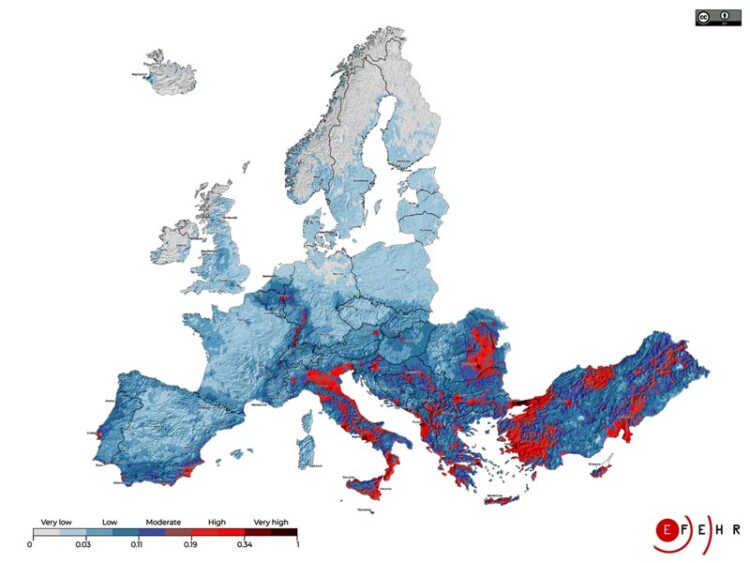Earthquake prediction with GSI sensor technology

Risk for earthquakes in Europe.
© CC-BY Artemis Project http://www.artemisproject.eu/wp-content/uploads/2022/09/EQ_RISK_Map_Legend_only.png?id=1991
Can nuclear physics improve the prediction of earthquakes?
That is the goal of the European research project artEmis, in which the GSI Helmholtzzentrum für Schwerionenforschung is participating together with twelve other institutes. Within the framework of artEmis, which is supported by an EU grant (Euratom) of two million euros until 2027, the foundation for a reliable early warning system for earthquakes is to be laid. A network of sensors measuring radon levels and other parameters in selected water sources in Europe might be able to detect earthquakes several days in advance.
Since the 1960s, earthquakes have been predicted by measuring radon gas, which leaks from microcracks in the bedrock due to movements in the Earth’s crust. “But is has become increasingly clear that the radon level measured in the air or soil can be influenced by temperature fluctuations and air humidity, so instead we’re measuring the values in the groundwater,” says Dr. Ayse Ataç Nyberg, professor at KTH Royal Institute of Technology in Sweden, who is leading the project.
GSI plays a key role in the project in terms of realizing the sensing and analytics. Building on particle and radiation detectors, signal processing electronics and data processing systems used for nuclear physics experiments at GSI facilities, the participating GSI research group is developing the sensor units for artEmis. In addition to radon detectors, the units will include sensors for temperature, pressure, conductivity and other physical parameters. By using artificial intelligence (AI) methods, which also result from basic research at GSI, the sensor units can be operated autonomously. GSI scientist Dr. Jürgen Gerl, who is responsible for the sensor units in the artEmis project with his team, confirms, “We are pleased to make an important contribution to the practical realization of an early warning system for earthquakes by applying detection systems and methods from our basic research.”
As a first step, measurements will be carried out on fault lines in Greece, Italy and Switzerland. Through research stations in these countries, the team has access to groundwater sources where sensor units can be placed. Hundreds of such units, distributed across the earthquake-prone areas, each form a network. Advanced analysis of the network data is performed using machine learning and AI. The goal here is to clearly link changes in local radon concentration to seismic activity and rule out other causes (false alarms).
Weitere Informationen:
https://www.gsi.de/en/start/news/details/2023/03/28/erdbebenvorhersage-mit-gsi-s…
http://www.artemisproject.eu/wp-content/uploads/2022/09/EQ_RISK_Map_Legend_only.png?id=1991
Media Contact
All latest news from the category: Earth Sciences
Earth Sciences (also referred to as Geosciences), which deals with basic issues surrounding our planet, plays a vital role in the area of energy and raw materials supply.
Earth Sciences comprises subjects such as geology, geography, geological informatics, paleontology, mineralogy, petrography, crystallography, geophysics, geodesy, glaciology, cartography, photogrammetry, meteorology and seismology, early-warning systems, earthquake research and polar research.
Newest articles

First-of-its-kind study uses remote sensing to monitor plastic debris in rivers and lakes
Remote sensing creates a cost-effective solution to monitoring plastic pollution. A first-of-its-kind study from researchers at the University of Minnesota Twin Cities shows how remote sensing can help monitor and…

Laser-based artificial neuron mimics nerve cell functions at lightning speed
With a processing speed a billion times faster than nature, chip-based laser neuron could help advance AI tasks such as pattern recognition and sequence prediction. Researchers have developed a laser-based…

Optimising the processing of plastic waste
Just one look in the yellow bin reveals a colourful jumble of different types of plastic. However, the purer and more uniform plastic waste is, the easier it is to…



